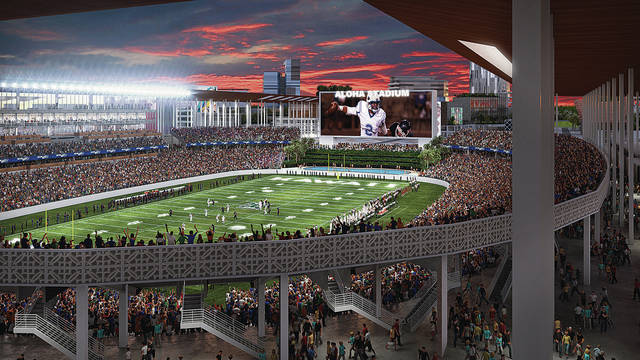The process of determining a successor to Aloha Stadium will enter its most significant phase in more than five years next month, when work on a stadium master plan and environmental impact statement is scheduled to commence.
The timeline was laid out at an Aloha Stadium Authority meeting Thursday in a closed-door executive session with representatives of the Department of Accounting and General Services planning branch.
Officials said afterward there is an agreement in principle with an as-yet- unannounced firm chosen for the project, with work expected to begin when the contract is executed “in the coming weeks.”
The Legislature has appropriated $10 million to finance the studies aimed at finalizing a site for a facility to replace the decaying 44-year-old stadium, which opened in 1975 with a construction price tag of $37 million.
In a statement of scope, the state has said the project “includes studies and related planning for demolition of the existing Aloha Stadium and for development and construction of a new stadium facility for the State of Hawaii. Consideration includes mixed use development of the entire Aloha Stadium Site.”
Officials said a due-diligence review of information on the stadium and analysis of possible alternate sites would be undertaken, but would not immediately put a number or location to them.
West Oahu and the University of Hawaii at Manoa campus areas have been among the most frequently speculated-upon potential sites over the years.
Based on consultants’ reports, the Stadium Authority last year recommended a 30,000- to 35,000-seat facility on the current footprint in Halawa with ancillary development tied to the coming of rail on the 98-acre site helping to defray costs. The stadium itself occupies 11.5 acres. A consultant’s report estimated a $132 million to $190 million price tag in 2014 dollars but warned that “each year that construction is delayed, costs will increase by approximately 4 percent per year.”
Then-UH athletic director Ben Jay commissioned a separate study in the same year in which a consultant recommended a 30,585-seat multipurpose facility for $165 million to $190 million (in 2014 dollars) but was not site-specific.
Once the master plan and EIS are completed, the state could issue a request for proposal for potential developers.
When the go-ahead is given and funds appropriated, a best-case scenario means work could begin in late 2021 or 2022, officials have projected.
Meanwhile a 2017 report warned that “the stadium currently requires approximately $421 million in critical health and safety repairs. This would cost the state approximately $30 million per year for 25 years and there is not enough operating revenue to support this maintenance.”
The Stadium Authority said in June it faced having to hold off on several priority health and safety repair items, including corrosion mitigation of steel bracing, replacement of concourse decks and some mauka seat plate repairs due to lack of appropriations. Soon after, an engineering report warned that without additional health and safety funding, the stadium may be forced to eventually close portions of the facility in the event of additional deterioration.
Stadium manager Scott Chan said the facility is currently safe. Stadium engineer Charlie Vitale said the stadium undergoes industry-standard inspections by structural engineers every two years, and inspectors can be summoned immediately if concerns arise.
Aloha Stadium facts
Opened: 1975
Seating capacity: 50,000
Original cost of construction: $37 million
Parcel: 98 acres, 11.5 of which take in the stadium
What’s next: Master plan and environmental impact statement

